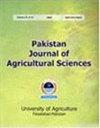日粮中dcad值对奶牛过渡期低钙血症的影响——综述
IF 0.6
4区 农林科学
Q3 AGRICULTURE, MULTIDISCIPLINARY
引用次数: 0
摘要
过渡时期(产犊前三周和泌乳前三周)是奶牛机体的剧烈变化,必须伴随着喂养方式的变化。围产期和哺乳期早期最重要的代谢性疾病之一是导致产后瘫痪的低钙血症。在众多原因中,干燥期饲料中钙含量高,阳离子(特别是Na+和K+)相对于阴离子(land s2 -)过量。它会导致血液pH值过高,从而损害甲状旁腺激素的活性。研究结果表明,饲喂负离子差(DCAD -饲粮阳离子-阴离子差)日粮可降低奶牛产后低钙血症。本文讨论了影响饲料日粮中DCAD值的因素及其在过渡时期优化DCAD值的可能性本文章由计算机程序翻译,如有差异,请以英文原文为准。
The influence of dcad value in feed ration on hypocalcaemia during transition period in cows – Review
Transition period (three weeks before calving and the first three weeks of lactation) is an intensive changes in the organism of cow which have to be accompanied by changes in feeding. One of the most important metabolic diseases of the periparturient and early lactation periods is hypocalcemia leading to postpartum paralysis. Among its many causes, there is high content of calcium in the feed ration during the dry period and the excess of cations, especially Na+ and K+ , in relation to anions (Cland S 2- ) in the feed. It results in too high blood pH, which impairs the activity of parathyroid hormone. Research results show that feeding negative cation-anion difference (DCAD – Dietary Cation-Anion Difference) ration reduces hypocalcaemia in cows in the postpartum period. In this review factors affecting DCAD values in the feed ration and possibilities of its optimization in the transition period has been discussed
求助全文
通过发布文献求助,成功后即可免费获取论文全文。
去求助
来源期刊

Pakistan Journal of Agricultural Sciences
AGRICULTURE, MULTIDISCIPLINARY-
CiteScore
1.80
自引率
25.00%
发文量
18
审稿时长
6-12 weeks
期刊介绍:
Pakistan Journal of Agricultural Sciences is published in English four times a year. The journal publishes original articles on all aspects of agriculture and allied fields.
 求助内容:
求助内容: 应助结果提醒方式:
应助结果提醒方式:


